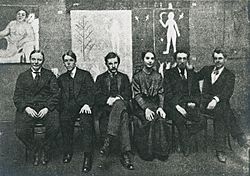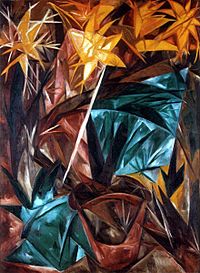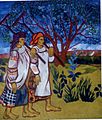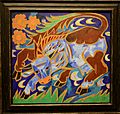Natalia Goncharova facts for kids
Quick facts for kids
Natalia Goncharova
|
|
|---|---|
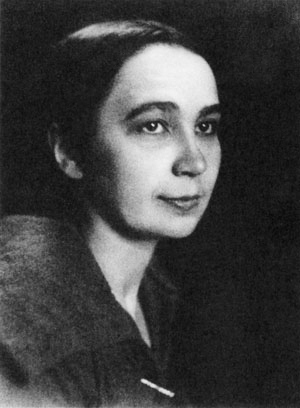
Goncharova in 1910
|
|
| Born |
Natalia Sergeevna Goncharova
3 July 1881 Nagaevo, Tula Governorate, Russian Empire
|
| Died | 17 October 1962 (aged 81) Paris, France
|
| Resting place | Ivry Cemetery, Ivry-sur-Seine, France |
| Nationality | Russian French (from 1938) |
| Education | Moscow Institute of Painting, Sculpture and Architecture |
| Known for | Painting, costume design, writer, illustrator, set designer |
| Movement | Russian Futurism, Rayonism, Primitivism |
Natalia Sergeevna Goncharova (Russian: Ната́лья Серге́евна Гончаро́ва; 3 July 1881 – 17 October 1962) was a very important Russian artist. She was a painter, costume designer, writer, illustrator, and set designer. She was known for being an avant-garde artist, which means she created new and experimental art.
Natalia Goncharova's partner for life was another Russian avant-garde artist, Mikhail Larionov. She helped start several art groups. These included the Jack of Diamonds (1909–1911) and the more daring Donkey's Tail (1912–1913). With Larionov, she also created a new art style called Rayonism (1912–1914). She was also part of a German art group called Der Blaue Reiter. Natalia was born in Russia but moved to Paris in 1921, where she lived until she passed away.
Her paintings had a huge impact on the new art movements in Russia. Her art shows in Moscow and St. Petersburg in 1913 and 1914 were the first to feature a "new" artist by an independent gallery. At a time when traditional painting was common, her modern way of painting religious art was quite shocking. She was a leading artist in Russia's modern art scene and continued to be influential in Paris.
Contents
Early Life and Family
Natalia Sergeevna Goncharova was born on 3 July 1881, in a place called Nagaevo, in Russia. Interestingly, other famous artists like Picasso and Léger were born in the same year!
Her father, Sergey Mikhaylovich Goncharov, was an architect. He studied at the well-known Moscow Institute of Painting, Sculpture and Architecture. Natalia moved to Moscow when she was 10 years old, in 1892. She finished school in 1898. Natalia Goncharova was also the great-granddaughter of the famous Russian poet Alexander Pushkin.
Her family was very educated and had modern ideas. Her father designed their home where Natalia and her brother Afanasii grew up. Their mother and grandmother taught them at home. They lived in different provinces before Natalia moved to Moscow for school. Before becoming an artist, she explored many subjects like zoology, history, botany, and medicine.
Becoming an Artist
In the fall of 1901, Natalia was accepted into the Moscow Institute of Painting, Sculpture, and Architecture. She first studied to be a sculptor under Pavel Trubetskoi. By 1903, her sculptures were shown in big art shows in Russia. She even won a silver medal for her sculpture in 1903–04. It was at this institute that she met Mikhail Larionov, who would become her lifelong partner. Soon, they began sharing a studio and living space.
At that time, women were not always allowed to get a full diploma from art schools, even if they completed their studies. So, in 1909, Natalia left the Moscow Institute. She continued her training at other studios, where she learned everything she would have at the institute if she had been male. In 1910, Natalia and other students were asked to leave a portrait class. This happened because they were copying the new, modern art styles from Europe.
Joining New Art Movements
Jack of Diamonds and Donkey's Tail
After being asked to leave their art class, Natalia and other students formed a new art group called the Jack of Diamonds. This was Moscow's first independent art group that dared to be different. The name was chosen by Larionov and was a bit rebellious.
The Jack of Diamonds had its first art show in 1910–11. Natalia showed paintings that used styles called Primitivist (inspired by simple, folk art) and Cubist (using geometric shapes). In 1912, the group split, and a more daring group called the Donkey's Tail was formed. At their first show, organized by Larionov, more than 50 of Natalia's paintings were on display. Natalia found inspiration for her Primitivist art in Russian icons and folk art, like luboks (popular prints).
The Donkey's Tail group wanted to create a unique Russian modern art style, separate from European influences. Their exhibition caused a stir. The authorities even took away Natalia's religious painting, The Evangelists (1910–11). They thought it was disrespectful because it mixed religious and everyday images. Also, it was unusual for women to paint icons at that time.
Russian Futurism and Rayonism
Natalia Goncharova and Mikhail Larionov often faced criticism for their art and how they expressed themselves. However, Natalia's later paintings clearly show the influence of Russian Futurism. This style focused on speed, technology, and modern life. At first, Natalia was interested in painting icons and the simple style of Russian folk art. But soon, she started mixing Cubist and Futurist ideas in her work. This led to a new style called Cubo-Futurism.
In Russia, she became famous for her works in this style, such as Cyclist. In 1911, she and Larionov created their own art style called Rayonism. They made many paintings in this style. Rayonism tried to show light rays and colors as lines crossing each other. As leaders of the Russian Futurists, they also held exciting talks, similar to what Italian Futurists did. Natalia also worked in graphic design, writing and illustrating several modern art books.
Natalia also took part in other important exhibitions, like The Target (1913) and No. 4 (1914). She was very important in Russian art at the time. Her artistic choices, which combined Eastern and Western traditions, helped inspire new art movements. She was a leading artist in Cubo-Futurist works (like Airplane over a Train, 1912) and Rayonist works (like Yellow and Green Forest, 1913).
Even though some of her art before World War I was seen as controversial, her participation in these shows helped blend Western European Modernism with Eastern traditions in Moscow's art scene. In one interview, she said she was inspired by artists like Picasso, but her own "Cubist" works actually came out a year before she mentioned this.
Natalia was also known for her sometimes shocking public actions. When she and Larionov first became interested in Primitivism, they would paint symbols and flowers on their faces and walk around the streets.
She also showed her art at the Salon d'Automne in 1906, which was a big art exhibition in Paris.
Later Career and Life in Paris
Natalia Goncharova was a founding member of the Der Blaue Reiter art group, starting in 1911. In 1915, she began designing costumes and sets for ballets in Geneva. That same year, she started working on designs for a ballet called Liturgy, which was planned by Sergei Diaghilev. Famous composer Igor Stravinsky was asked to write the music for it, but the ballet was never performed.
In 1921, Goncharova moved to Paris. There, she designed many stage sets for Diaghilev's famous Ballets Russes dance company. She also regularly showed her art at major Paris exhibitions like the Salon d'Automne, the Salon des Tuileries, and the Salon des Indépendants.
Goncharova also connected with an art movement called Everythingism (Vsechestvo) in Russia. This movement was an extension of Neo-Primitivism. Everythingism promoted mixing many different cultural traditions, like East and West, and different art styles, like Cubism and Futurism. It aimed to remove the differences between original art and copies, bringing them together. It was an art movement that was free from old art rules.
Natalia and Larionov left Russia and moved to Paris on 29 April 1914. That year, she designed costumes and sets for the Ballets Russes's first performance of The Golden Cockerel in Paris. Goncharova and Larionov also worked together on four special events in Paris to help the Union of Russian Artists. These events included big costume balls like the Grand Bal des Artistes (1923) and the Bal Banal (1924). They designed many of the posters and materials for these events.
Between 1922 and 1926, Natalia Goncharova created fashion designs for Marie Cuttoli's shop, Maison Myrbor, in Paris. Her beautiful dress designs, with rich embroidery and appliqué (fabric pieces sewn on), were strongly inspired by Russian folk art, Byzantine mosaics, and her work for the Ballets Russes.
In 1938, Goncharova became a French citizen. On 2 June 1955, she and Larionov got married in Paris. This happened four years after Larionov had a stroke, and they married to protect their legal rights. Her art style changed over time, moving from Cubism to a more classical style, influenced by the School of Paris. Natalia Goncharova was the first of the two artists to pass away, on 17 October 1962, in Paris. She had been struggling with rheumatoid arthritis.
Artistic Style
Natalia Goncharova's art often showed the differences between country life and city life. This made her art part of the European and Russian Modernism of her time. The busy life of Moscow and the peaceful summer breaks in the countryside are very clear in her art. Photos show her wearing peasant clothes with city shoes at her family's country estate.
Her early self-portraits explored her identity. She sometimes dressed up in fancy clothes, or showed herself in a home setting. Other portraits focused on her identity as a painter, like Self-Portrait with Yellow Lilies (1907).
Her early pastel drawings and paintings were influenced by her family's main estate in Kaluga province. Life there seemed to mix work and leisure, which might connect to the modern changes happening in Russia at the time. Goncharova was inspired by watching the daily lives of the servants and peasants who lived there. This is clear in her many paintings of gardens, which can be linked to the landscape of this property.
Fashion and Costume Design
Natalia Goncharova had a very successful career in fashion, especially designing costumes for the Ballets Russes. Her designs were a mix of her modern art ideas and her Russian background. In France, she worked for the House of Myrbor, where her Slavic heritage influenced the abstract designs that were popular with modern artists.
She also worked for a famous designer named Nadejda Lamonava in Moscow. There, she could fully express her artistic ideas. She experimented with abstract designs, colors, patterns, and different materials. She was clearly going against the popular fashion for Orientalism (styles inspired by the East). Her designs were influenced by both Russian traditions and Byzantine mosaics, which you can see in her costumes and dresses. Her work also showed elements of Primitivism.
She designed many costumes for the Ballets Russes, especially for their shows The Golden Cockerel (Le Coq d'Or) and Firebird. She was a key part of the Ballets Russes and worked closely with Sergei Diaghilev. Her work had a big impact on French fashion at the time, even influencing famous designer Paul Poiret.
Important Dates
- 1881: Born on 21 June in Nagaevo, Russia.
- 1892–98: Moves to Moscow and attends the Fourth Women's Gymnasium.
- 1900: Meets Mikhail Larionov, her lifelong partner.
- 1901: Attends the Moscow Institute of Painting, Sculpture, and Architecture.
- 1906–07: Develops her Primitivism style.
- 1908–10: Uses Cubism style and takes part in three exhibitions in Moscow.
- 1910: Helps start the Jack of Diamonds group and shows her art in their first exhibition.
- 1912: Her work is shown at the Der Blaue Reiter exhibition in Munich and the Second Post-Impressionist Exhibition in London.
- 1912–14: Works in Cubo-Futurist and Rayonist styles.
- 1913–14: A large exhibition of her work is held in Moscow.
- 1914: Moves to Paris with Larionov on 29 April.
- 1917: Travels to Spain and Italy with Diaghilev's dance company. Settles in Paris with Larionov.
- 1920: Shows art at the Exposition Internationale d’Art Moderne in Geneva.
- 1922: Has an exhibition at the Kingore Gallery in New York.
- 1954: Her and Larionov's work is shown at a Diaghilev exhibition in Edinburgh and London.
- 1955: Goncharova and Larionov get married.
- 1961: The Arts Council of Great Britain organizes a major exhibition of both their works.
- 2019: A large exhibition of her work is held at Tate Modern in London.
- 2019–20: A major exhibition on Goncharova is held at the Palazzo Strozzi in Florence.
- 2020: The exhibition from Tate Modern and Palazzo Strozzi moves to Helsinki, Finland.
Legacy and Art Market
Natalia Goncharova's art can be found in many public museums around the world, including:
- Museum of Modern Art
- Museum of New Zealand Te Papa Tongarewa
- Tate
- Israel Museum
- McNay Art Museum
- Guggenheim, New York
Art Sales
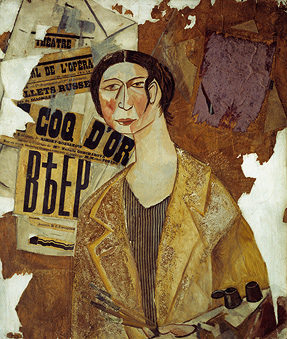
Natalia Goncharova's paintings have sold for very high prices. On 18 June 2007, her 1909 painting Picking Apples was sold at an auction for $9.8 million. This set a new record for any female artist at that time. She is considered one of the most expensive women artists at auction. Her work is often featured in Russian art auctions held in London.
In November 2007, her painting Bluebells (1909) sold for £3.1 million ($6.2 million). In 2008, her 1912 still-life painting The Flowers sold for $10.8 million.
Finding Lost Works
In 2019, an expert studying the artist Růžena Zátková found two of Goncharova's paintings that no one knew about before. These two works were dedicated to Zatkova and were from 1916. The two artists had been friends since 1915. This was when Sergei Diaghilev invited them and his dance group, the Ballets Russes, to stay with him in Switzerland. The paintings were made while Zatkova was sick.
Tributes
On 3 July 2017, Google celebrated Natalia Goncharova's 136th birthday with a special Google Doodle on their homepage.
Filmography
- Drama in the Futurists' Cabaret No. 13 (some parts of this film are lost)
Gallery
See also
 In Spanish: Natalia Goncharova para niños
In Spanish: Natalia Goncharova para niños


